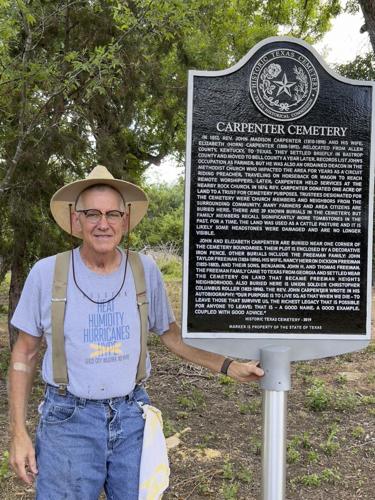Hidden Temple cemetery to unveil state historic marker
Published: Tue, 01/16/24
Hidden Temple cemetery to unveil state historic marker

Dan Nixon, treasurer of the Carpenter Cemetery Association, stands next to the new Texas Historic Marker that will officially be dedicated during a Jan. 27 ceremony.
Courtesy
Killeen Daily Herald
BY DAVID STONE | SPECIAL TO THE TELEGRAM
January 15, 2024
A Texas Historic Marker at an obscure community cemetery tucked away on private land near the intersection of Kegley Road and Charter Oak Drive will be unveiled at a ceremony on Saturday, Jan. 27.
The cemetery dates back to 1879.
“We believe there could have been more than 60 people buried at the cemetery,” said Curtis Smith, secretary of the Carpenter Cemetery Association. The cemetery served the Midway community for years.
“Family members recall significantly more tombstones in the past,” he said. “For a time, the land was used as a cattle pasture, and it is likely some of the headstones were damaged and are no longer visible.”
Until a couple years ago, the cemetery was overgrown with weeds and brush, and many of the tombstones were in poor condition.
“We cleared the cemetery and built a fence around it, and we’ve been repairing some of the headstones,” Smith said. “We’ve done a lot of work, and the marker dedication will give ancestors of those buried there the chance to see the improvements.”
There is no public access to the cemetery — it is behind at least two padlocked gates — but arrangements will be made to get in and out on Jan. 27 by calling 409-673-6048 or emailing thecarpentercemtery@gmail.com.
“Descendants from across the state and the world have contributed their time and money to help preserve this important historical location,” Smith said. “The preservation of the cemetery would not have been possible without the support of the Bell County Historical Association and the Bell County Sheriff’s Office.”
According to Smith, Sheriff’s Department volunteers have helped with the upkeep of the property.
In 1852, Rev. John Madison Carpenter (1810-1898) and his wife, Elizabeth Horn Carpenter (1808-1892), relocated from Allen County, Kentucky, to Texas. They settled briefly in Bastrop County and moved to Bell County a year later.
Records list John’s occupation as farmer, but he was also an ordained deacon in the Methodist Church who traveled the area for years as a circuit-riding preacher, traveling on horseback or wagon to reach remote worshippers.
Later, Carpenter held services at the nearby Rock Church.
In 1874, Carpenter donated one acre of land to a trust for cemetery purposes. Trustees designated for the cemetery were church members and neighbors from the surrounding community. Many farmers and former residents of the area are buried here.
John and Elizabeth Carpenter are buried near one corner of the cemetery boundaries, according to Smith. Their plot is enclosed by a decorative iron fence. Other burials include the Freeman family: John Taylor Freeman (1824-1896), his wife Nancy Herron Dickson Freeman (1825-1883), and their sons Benjamin, John H. and Thomas Freeman.
The Freeman family came to Texas from Georgia and settled on land that became the Freeman Heights Neighborhood. Also buried here is Union soldier Christopher Columbus Roller (1822-1896).
The Carpenter Cemetery is a portrait of everyday Texans who made an impact on their community and in the lives of their descendants.
The Rev. John Carpenter wrote in his autobiography: “Our purpose is to live so that when we die we leave those that survive us the richest legacy that is possible coupled with good advice.”